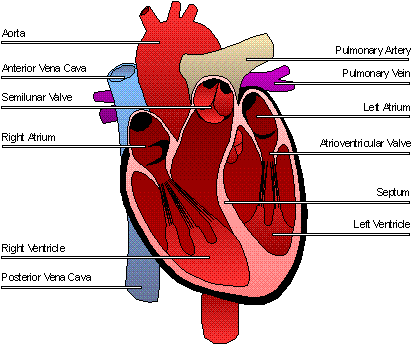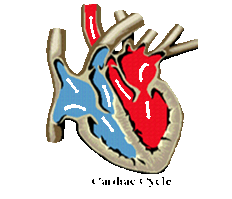The Heart
The heart is one of the most vital organs in the entire human body. It is really nothing more than a pump, composed of muscle which pumps blood throughout the body. It beats approximately 72 times per minute of our lives. The heart pumps the blood, which carries all the vital materials which help our bodies function and removes the waste products that we do not need.For example, the brain requires oxygen and glucose, which, if not received continuously, will cause it to loose consciousness. Muscles need oxygen, glucose and amino acids, as well as the proper ratio of sodium, calcium and potassium salts in order to contract normally. The glands need sufficient supplies of raw materials from which to manufacture the specific secretions. If the heart ceases to pump blood to the body parts through arteries and veins a person will die in a very short period of time.
The heart is a muscular organ(a little larger than the fist). Like any other muscle in the human body, it contracts and expands. Unlike skeletal muscles, the heart does its works. Each times the heart contracts it does so with all its force. In skeletal muscles, the principle of "gradation" is present. The pumping of the heart is called the Cardiac Cycle, which occurs about 72 times per minute. This means that each cycle lasts about eight-tenths of a second. During this cycle the entire heart actually rests for about four-tenths of a second.
How the heart is made?:The walls of the heart are made up of three layers, while the cavity is divided into four parts. There are two upper chambers, called the right and left
atria, and two lower chambers, called the right and left ventricles. The Right Atrium, as it is called, receives blood from the upper and lower body through the
superior vena cava and the inferior vena cava, respectively, and from the heart muscle itself through the
coronary sinus. The right atrium is the larger of the two atria, having very thin walls. The right atrium opens into the right ventricle through the
right atrioventicular valve(tricuspid), which only allows the blood to flow from the atria into the ventricle, but not in the reverse direction. The right ventricle pumps the blood to the lungs to be reoxygenated. The left atrium receives blood from the lungs via the four
pulmonary veins. It is smaller than the right atrium, but has thicker walls. The valve between the left atrium and the left ventricle, the
left atrioventicular valve(bicuspid), is smaller than the tricuspid. It opens into the left ventricle and again is a one way valve. The left ventricle pumps the blood throughout the body. It is the
Aorta, the largest artery in the body, which originates from the left ventricle.
The Heart works as a pump moving blood around in our bodies to nourish every cell. Used blood, that is blood that has already been to the cells and has given up its nutrients to them, is drawn from the body by the right half of the heart, and then sent to the lungs to be reoxygenated. Blood that has been reoxygenated by the lungs is drawn into the left side of the heart and then pumped into the blood stream. It is the atria that draw the blood from the lungs and body, and the ventricles that pump it to the lungs and body. The output of each ventricle per beat is about 70 ml, or about 2 tablespoons. In a trained athlete this amount is about double. With the average heart rate of 72 beats per minute the heart will pump about 5 litres per ventricle, or about 10 litres total per minute. This is called the cardiac output. In a trained athlete the total cardiac output is about 20 litres. If we multiply the normal, non-athlete output by the average age of 70 years, we see that the cardiac output of the average human heart over a life time would be about 1 million litres.



